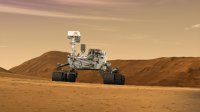The Whirligig Aerospace Challenge Lab
Using inexpensive supplies and six engineering practices, students design a paper Mars lander in this simple lesson.
Do your students love space exploration? Got some tape, paper, scissors, paper clips, and a copier? Then you can have your students engineer a simple model of one of NASA’s most ambitious vehicles—and you’ll be incorporating the Next Generation Science Standards engineering practices in your instruction at the same time.
The Whirligig Aerospace Challenge Lab is a modest yet engaging way to get kids—from eighth graders up to physics students in high school—practicing the Engineering Design Process by approaching it via a real Mars mission.
Science education should combine the traditional curiosity of science with the problem solving of engineering. The whirligig investigation and worksheets will help you hit six of the eight engineering practices: defining problems, making models, carrying out investigations, interpreting data, constructing and designing solutions, and communicating information.
Building a Mars Lander
The first step is to show the video “7 Minutes of Terror,” one of the more entertaining NASA videos I’ve seen. After watching the video with my students, I ask them a few questions to get them to recall quantitative information in the video, letting them know that these are big numbers. You can tailor the questions to your classroom’s ability and interest. This opening dialogue with students helps them learn about the immense challenges NASA engineers face.
- What was the main challenge of landing the rover Curiosity on Mars? (Slowing it down from 13,000 miles an hour to zero.)
- How long did it take the rover to go from entering Mars’ atmosphere to landing? (7 minutes)
- How long does it take a radio transmission to travel from Mars to Earth? (14 minutes—imagine if your text or Instagram photo took 14 minutes to post!)
- How many pounds of pressure were being applied to the rover as it was slowing down? (About 18,000 pounds—think of a bus coming at you at 13,000 miles an hour.)
- How many degrees of heat did the heat shield have to withstand? (1,600 degrees)
- What was the margin of error? (Zero—the rover would crash and be smashed to pieces if the mission were not 100 percent successful.)
Explain to students that even NASA engineers start with simple models before moving on to bigger and more expensive prototypes. Lab groups will compete against each other to solve this engineering problem: to build the slowest whirligig, one that resists gravity by spinning.
Before I hand out the pre-lab, I drop one of my paper whirligigs and a ball at the same time, and ask students why the ball hit the ground first. Answers should relate to the spinning of the wings, creating lift, moving air molecules, etc. You can tailor this to the level of your students’ understanding of the four forces of flight. An extension of this lab may be to review the four forces, and how the whirligig uses gravity, drag, and lift, but not thrust. You can also point out whirligigs in nature—e.g., the maple tree uses whirligig pods to disperse its seeds.
After each group fills out a pre-lab, I give them their supplies: scotch, masking, and painters tape; large and small paper clips; scratch copy paper; and whirligig templates. Do not hand out the scissors just yet.
Design time: Have your students spend five to 10 minutes looking at the templates and supplies, and encourage them to draw designs and discuss what might make a good design before they start cutting. They should design two models, using the templates or drafting one of their own with the same basic design as the template.
It is the modifications they apply to their whirligigs that will create a slow-falling craft. Modifications include: changing the size, shape, and curve of the propellers; adding weight on the base with tape, paper clips, or extra paper; and creating 3D shapes such as loops and triangles with paper. It’s important to encourage design thinking now—before they actually make a model.
Select and prototype: Now you can hand out the scissors. Have students build their two whirligigs, test them, and pick their best model, the one that gracefully and slowly spins to the floor. I usually give them about 30 minutes to do this, with regular warnings about how much time is left. Encourage and lead students to apply design thinking by telling them explicitly about the modifications they can make. Tell them to think of propeller craft they are familiar with. The important thing is to modify the template in as many ways as possible to create the slowest craft possible.
Test and evaluate: This is the fun part. Kids can get pretty competitive, so set the rules out clearly: The tallest kid in class will be the launchpad. Groups will go head to head, two at a time. The “launchpad” will lift two whirligigs over his or her head as high as possible and let them go. The winner is the whirligig that touches ground last—you decide the winner of each test flight—and the winner goes to the next round. The final team with the slowest whirligig wins the challenge. Give the winning team some candy or a homework pass—or bragging rights can suffice.
Communicate and reiterate: I always do a quick class discussion after the competition. I have a whirligig reflection worksheet where students draw their model and write a power conclusion on their challenge experience if time allows. Congratulate all the teams and give a big round of applause to the launchpad.
You don’t have to have fancy building kits to get kids designing, building, and testing. The Whirligig Aerospace Challenge Lab will have your students engineering away, trying to best their classmates while modeling our efforts to explore deep space. As Carl Sagan said, “Science is more than a body of knowledge. It’s a way of thinking.” Drive your students to this type of thinking.
